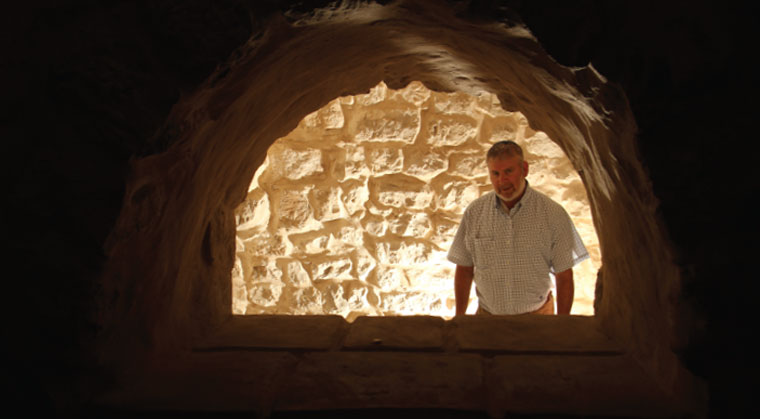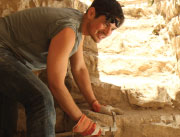Rebuilt from the Inside


IGNITE THE LIGHT Whether it’s digging through ancient ruins restoring bomb shelters or fixing up the homes of the poor Aharon Botzer learned the secret – there’s nothing like building Eretz Yisrael to ignite that Jewish spark (Photos: Menachem Kalish)
F
inding Aharon Botzer is not easy. Livnot U’Lehibanot the Jewish experience organization of which he is founder and director sits right in the middle of the maze of intriguing alleyways ancient synagogues and artists’ galleries that is Tzfas’sOldCity. And the campus of Livnot U’Lehibanot is itself even more of a sprawling maze of ancient stone staircases arched entrances and curiously shaped rooms.
Aharon is finally unearthed buried in one of Livnot’s semi-subterranean offices. But the interview — at least at first — takes place on the top floor of Livnot’s three-story main building on Simtat Alkabetz in a spacious airy room aesthetically dotted with arched nooks and exotic cushions — perfect for the seminars and workshops held here — and facing the panoramic windows with their breathtaking view across to Mount Meron.
To understand who Aharon Botzer is and the life journey he has taken one first needs to take a look at the organization that he has created from scratch of which he is the driving force and inspiration. In 1980 Livnot U’Lehibanot (Hebrew for “To Build and Be Built ”) was founded and it’s a perfect name for an organization that does just that — building and rebuilding both Jewish souls and Jewish history. One ofIsrael’s top ten nonprofit organizations Livnot runs a range of innovative Jewish experience programs exploringIsraeland Jewish heritage through a blend of hiking community service seminars and learning serving young Jewish adults aged 21 to 30 with little Jewish background.
Hikes through the Galilee countryside help open the participants’ eyes to Torah perspectives on nature; community service programs from building forest trails to renovating city bomb shelters give the youth an opportunity to benefit their fellow Jews and at the same time develop a connection with them; and seminars and workshops on a wide range of Jewish topics stimulate their intellect and curiosity about what it means to be a Jew. The experience most alumni agree can be life-changing — and indeed many have changed their lives to take on Torah and mitzvos while others come away with a positive feeling about their Jewish identity and heritage.
Searching for the Source
What pushed Aharon to create such an organization to help youths discover their Jewish identity? The answer lies in his own journey of exploration.
“You could say I come from an average typical American Jewish family — my mother kept kashrus before I was born” Aharon explains. He grew up inClevelandOhio in a neighborhood that housed many types of Jews and his family belonged to a Conservative synagogue. But Aharon had no contact with his religious neighbors.
“I never exchanged a word with the ‘frummies’ in my neighborhood” he says. “They lived in a separate world. I thought they were fanatics.”
The next step on Aharon’s journey took him to a wrestling scholarship atOhioUniversity where he earned a degree in education. In his last year of college he was competing in a wrestling match inWashingtonD.C. and was injured. It was a fortuitous injury. For that was in 1969 just when theUSgovernment was drafting men forVietnam.
“They were calling up people according to birth dates and I had one of the first dates” says Aharon. “And because I was so athletic I would probably have gotten sent into combat over there. But because of my back injury the army wouldn’t take me. And miraculously my back was fine afterward — I served as a machine gunner in the IDF and never had any problems!”
During the vacations Aharon liked to travel and explore and at that time hitchhiking was an accepted way to go. One year he ended up inMexico.
“I was going to go to a summer school at theAmericanUniversityinMexico” he tells me “but it wasn’t what I wanted. So I left and found myself in a little village in the mountains. There was a monastery there and they asked me if I could organize a group of volunteers — something like the Peace Corps — to come and help them. So I brought a group over from theAmericanSchool.”
Aharon and his gang worked on various projects such as building chimneys for the village houses. The villagers built fires inside their houses but had no outlet for the smoke; because the air they were breathing was so unhealthy the average life expectancy was about 30 due to widespread tuberculosis. But says Aharon only a few days after his gang had built the chimneys all the villagers had clogged up the chimneys again. Why?
“Because once the smoke had gone the flies came in — and the villagers preferred the smoke” he explains. “This was such an important lesson for me — that we don’t always know what’s best for others.”
The next year Aharon returned to the same site where he helped build a bridge in some way-out site three days’ trip by donkey. It was here that Hashem gave Aharon the push to change direction. “The place where we were working was an amazing place and while I was there someone gave me The Source by James Michener. I read it and decided I had to come toIsrael. I know it’s not a history book it’s fiction but it’s an incredible book.”
That was Aharon’s first push towardIsraeland Judaism. But there were other things. “InMexico which is predominantly Catholic the people in the villages out there still really believe the Jews killed their Messiah” he explains. “And they also really believe Jews have horns. Everywhere I went they would say to me ‘Take off your hat — we want to see your horns!’ ”
In a short space of time Aharon was on the next stage of his journey on a nonreligious kibbutz inIsrael. He was shocked by what he found there.
“I wasn’t religious myself but I couldn’t believe it was so so antireligious” he says. “So I upped and walked to Sdeh Eliyahu a nearby religious kibbutz. They never took volunteers but I happened to turn up at a good time when they needed help so they let me in.”
Aharon stayed at the kibbutz for a year or so learning in ulpan after which he decided to go learn seriously in yeshivah in Jerusalem. During that period he was gradually becoming frum and taking on the mitzvos. After yeshivah Aharon took a job teaching English in the high school in Kiryat Shemoneh. After another period of learning this time in Mercaz Harav inJerusalem Aharon arrived in what one feels is his spiritual home.
“I got a job teaching in Tzfas and fell in love with the place” he says simply.
Building the Cornerstone
It was 1974 when Aharon arrived in Tzfas and theOldCitywas still full of deserted ruins. Aharon bought one a ruin that no one wanted with a dereliction order on it for next to nothing. He built up the house with his own two hands adding two stories and so he found himself with a big house on his hands. At first he rented it out to teachers year round and tourists in the summer. Then things started to take on a life of their own.
“Many people who had come from the kibbutzim with their backpacks searching for something more than what they found on the kibbutz passed through Tzfas” Aharon explains.

“They wanted something Jewish¬ but then there were only yeshivos to send them to and these people weren’t ready for that” Aharon says
Aharon and his new wife Miriam whom he had met and married while building his house began inviting them home for the Shabbos meal and got to know them.
“They wanted something Jewish but then there were only yeshivos to send them to and these people weren’t ready for that or they tried and it was too intimidating. I felt they needed something in between something that let them experience Judaism without feeling the push from behind to make them frum. Some people don’t agree with Livnot because we offer options that are not strictly religious. But I tell them if the options is ‘all or nothing ’ most people will choose nothing.”
And so in 1980 Livnot U’Lehibanot was born. As their well-designed website explains Livnot “offers an integratedIsraelexperience of volunteering hiking and community building that allows participants to explore themselves and connections to their Jewish roots and heritage.” Livnot’s programs include short-term Israel Programs such as the one-week Northern Exposure program and the longer Onward Israel – Galilee Trek and Connect program a six-week internship and community service program based in Tzfas.
Oops! We could not locate your form.







